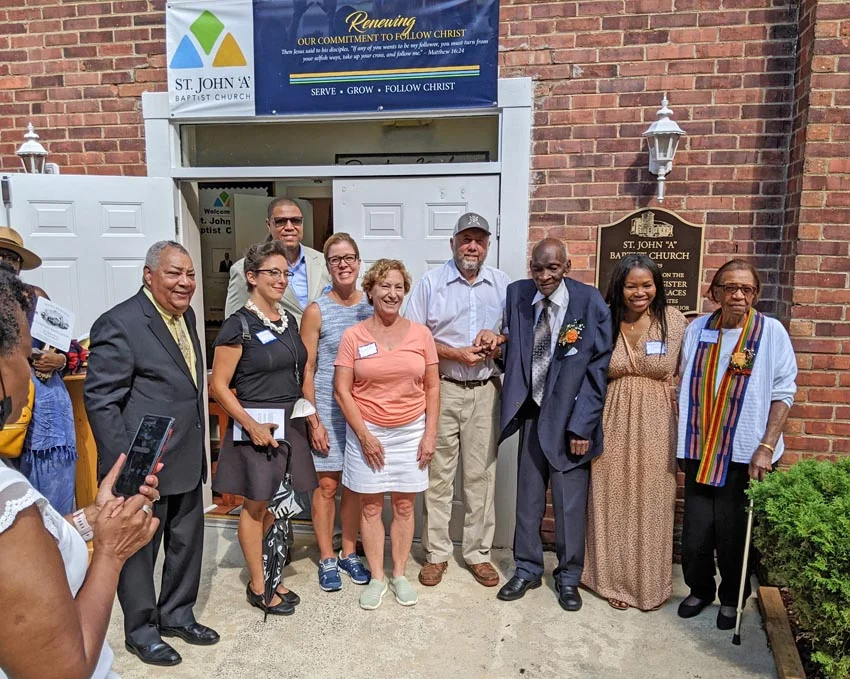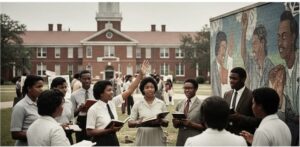St. John “A” Baptist Church Listed on National Register of Historic Places

Burial place of slaves and Black residents and adjacent Black church given federal protection.
A gathering of church and local elected and civic leaders unveiled a plaque on the St. John “A” Baptist Church recently.
The plaque states that the historic Black church is now listed on the National Register of Historic Places. The ceremony also commemorated the listing of the adjacent South Asheville Cemetery on the National Register. It is the only cemetery on the Register in Buncombe County,
The church and cemetery will join other notable landmarks such as All Souls Episcopal Church, the Biltmore Estate and the Young Men’s Institute (YMI) on the list of sites, buildings, structures and objects deemed worthy of preservation for their historical significance.
“This celebration is a long time coming,” said George Gibson, board member emeritus of the South Asheville Cemetery Association. Gibson, 94 years old, often worked alongside George Avery, the former enslaved person who was designated the first cemetery caretaker digging graves and other needed work. He shared stories of working alongside Avery and leading a group of dedicated volunteers over many decades to reclaim the
cemetery from weeds and debris that once swamped it.
The St. John “A” congregation first began when South Asheville residents joined with others for prayer meetings under a large oak tree in Haw Creek. Around 1920, St. John “A” Baptist Church and St. Mark AME, which is no longer in existence, joined to form a Cemetery Board/Burial Association to continue the work of maintaining the cemetery grounds, digging graves and collecting burial fees with George Avery continuing as the caretaker.
The current St. John “A” Baptist Church, under the shepherding of newly installed Reverend Ronald B. Webb, Jr., evolved over the years from the 1929 structure constructed in the historic Black neighborhood of South Asheville. It is the third church structure on the site. The neighborhood had been annexed by the then Town of Kenilworth in 1928. However, the church and cemetery were left out of that annexation. Church members would organize volunteer days twice a year to clean graves, clear brush and debris, and tidy the grounds.
“These activities to preserve the cemetery are still carried out by volunteers to this day,” noted Dr. Ellen Holmes Pearson, chair of the South Asheville Cemetery Association board of directors. “We organize several volunteer days that now include local residents, civic groups, college students, and many others to do the work once solely done by members of the two church congregations.”
For years South Asheville Cemetery was one of the few cemeteries that permitted Black burials. Recent research found that perhaps as many as 3,000 people are buried there. The cemetery started seeing fewer burials after other cemeteries opened or permitted Black burials. It fell into disrepair and nearly disappeared completely under vines, weeds, and trashed dumped on the grounds.
“There are currently no public funds that other cemeteries have to maintain South Asheville Cemetery, much less do the urgently needed work of repairing and replacing headstones or restoring graves,” continued Holmes Pearson. “In 1952, Asheville’s Riverside Cemetery, which was having financial problems, was taken over by the City of Asheville, which still maintains it today. South Asheville Cemetery was neglected and left to fend for itself.”
“If not for the stewardship of church members like George Gibson and George Taylor and other members of this congregation, the cemetery would have disappeared under the weeds or worse under development that was proposed at the boundaries of the cemetery,” said Rev. Webb. “Getting the church and the cemetery on the National Register will help bring us grants and donations to complete the work of rescuing and restoring these important Western North Carolina landmarks of Black history.”








